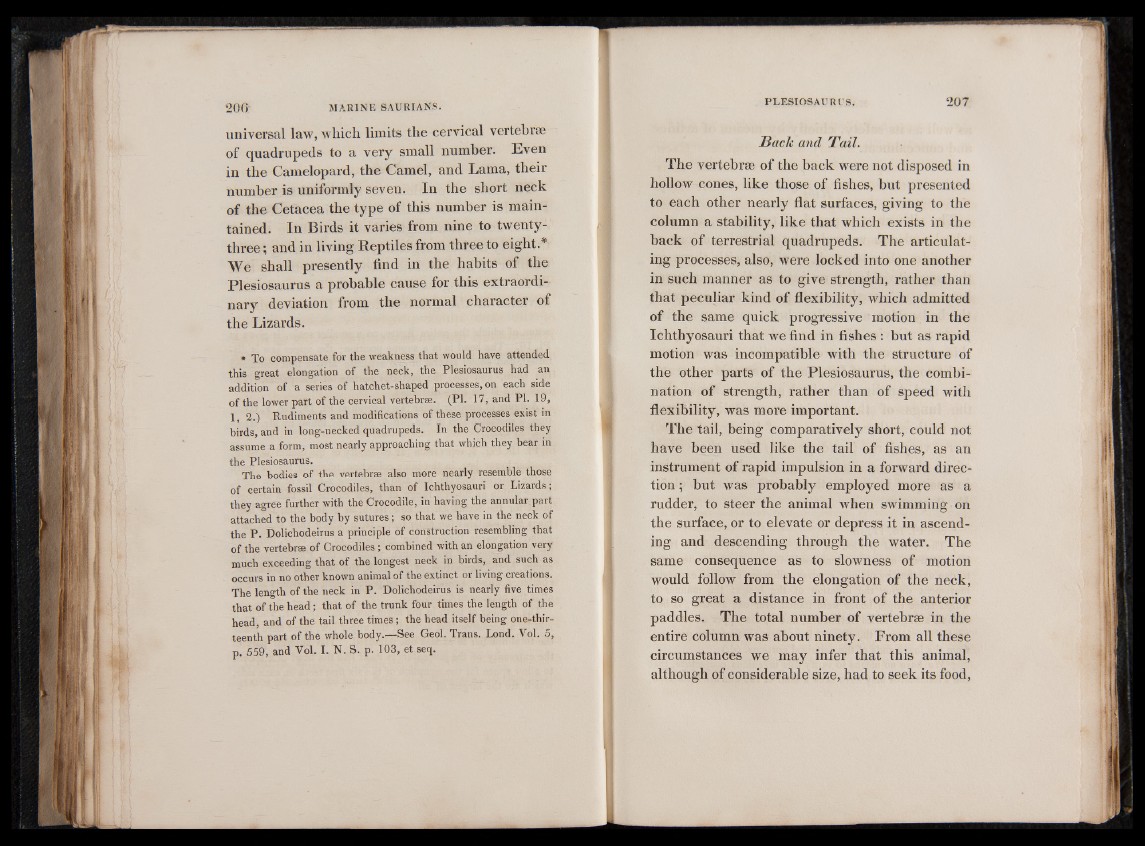
universal law, which limits the cervical vertebrae
of quadrupeds to a very small number. Even
in the Camelopard, the Camel, and Lama, their
number is uniformly seven. In the short neck
of the Cetacea the type of this number is maintained.
In Birds it varies from nine to twenty-
three ; and in living Reptiles from three to eight*
We shall presently find in the habits of the
Plesiosaurus a probable cause for this extraordinary
deviation from the normal character of
the Lizards.
* To compensate for the weakness that would have attended,
this great elongation of the neck, the Plesiosaurus had an
addition of a series of hatchet-shaped processes, on each side
of the lower part of the cervical vertebrae. (PI. 17, and PI. 19,
1, 2.) Rudiments and modifications of these processes exist in
birds, and in long-necked quadrupeds. In the Crocodiles they
assume a form, most nearly approaching that which they bear in
the Plesiosaurus.
The bodies of the vertebrae also more nearly resemble those
of certain fossil Crocodiles, than of Ichthyosauri or Lizards;
they agree further with the Crocodile, in having the annular part
attached to the body by sutures; so that we have in the neck of
the P. Dolichodeirus a principle of construction resembling that
of the vertebrae of Crocodiles ; combined with an elongation very
much exceeding that of the longest neck in birds, and such as
occurs in no other known animal of the extinct or living creations.
The length of the neck in P. Dolichodeirus is nearly five times
that of the head; that of the trunk four times the length of the
head, and of the tail three times; the head itself being one-thirteenth
part of the whole body.—See Geol. Trans. Lond. Vol. 5,
p. 559, and Vol. I. N. S. p. 103, et seq.
Back and Tail.
The vertebrae of the back were not disposed in
hollow cones, like those of fishes, hut presented
to each other nearly flat surfaces, giving to the
column a stability, like that which exists in the
back of terrestrial quadrupeds. The articulating
processes, also, were locked into one another
in such manner as to give strength, rather than
that peculiar kind of flexibility, which admitted
of the same quick progressive motion in the
Ichthyosauri that we find in fishes : but as rapid
motion was incompatible with the structure of
the other parts of the Plesiosaurus, the combination
of strength, rather than of speed with
flexibility, was more important.
The tail, being comparatively short, could not
have been used like the tail of fishes, as an
instrument of rapid impulsion in a forward direction
; hut was probably employed more as a
rudder, to steer the animal when swimming on
the surface, or to elevate or depress it in ascending
and descending through the water. The
same consequence as to slowness of motion
would follow from the elongation of the neck,
to so great a distance in front of the anterior
paddles. The total number of vertebrae in the
entire column was about ninety. From all these
circumstances we may infer that this animal,
although of considerable size, had to seek its food,